Friday, May 14
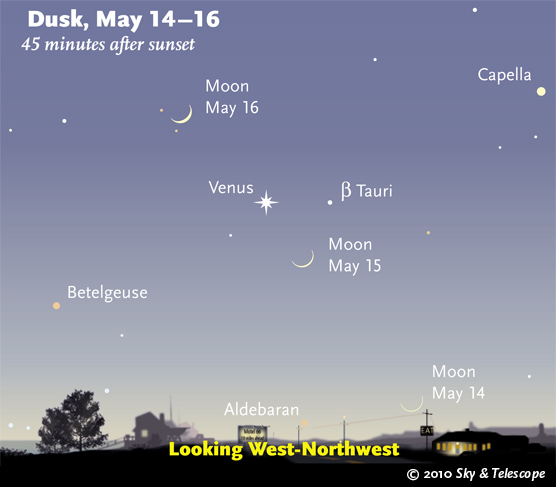
Watch the Moon passing Venus in twilight. These diagrams are drawn for the middle of North America. European skywatchers: move each Moon symbol a quarter of the way to the one for the previous date. The visibility of faint objects in bright twilight is exaggerated here.
Sky & Telescope diagram
Saturday, May 15
Sunday, May 16
Monday, May 17
Tuesday, May 18
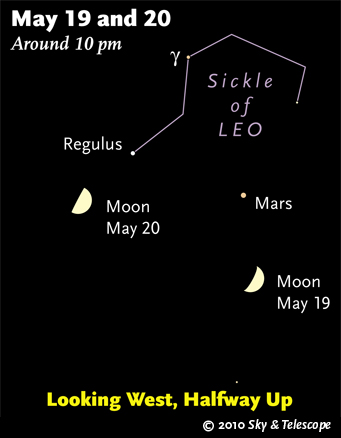
The Moon passes under Mars and Regulus on Wednesday and Thursday nights.
Sky & Telescope diagram
Wednesday, May 19
Thursday, May 20
Friday, May 21
Saturday, May 22
Want to become a better amateur astronomer? Learn your way around the constellations. They're the key to locating everything fainter and deeper to hunt with binoculars or a telescope.

The Pocket Sky Atlas plots 30,796 stars to magnitude 7.6 — which may sound like a lot, but that's less than one star in an entire telescopic field of view, on average. By comparison, Sky Atlas 2000.0 plots 81,312 stars to magnitude 8.5, typically one or two stars per telescopic field. Both atlases include many hundreds of deep-sky targets — galaxies, star clusters, and nebulae — to hunt among the stars.
Sky & Telescope
For an easy-to-use constellation guide covering the whole evening sky, use the big monthly map in the center of each issue of Sky & Telescope, the essential magazine of astronomy. Or download our free Getting Started in Astronomy booklet (which only has bimonthly maps).
Once you get a telescope, to put it to good use you must have a detailed, large-scale sky atlas (set of charts). The standards are the Pocket Sky Atlas, which shows stars to magnitude 7.6; the larger Sky Atlas 2000.0 (stars to magnitude 8.5); and the even larger and deeper Uranometria 2000.0 (stars to magnitude 9.75). And read how to use your charts effectively.
You'll also want a good deep-sky guidebook, such as Sky Atlas 2000.0 Companion by Strong and Sinnott, or the more detailed and descriptive Night Sky Observer's Guide by Kepple and Sanner or the classic if dated Burnham's Celestial Handbook.
Can a computerized telescope take their place? I don't think so — not for beginners, anyway, and especially not on mounts that are less than top-quality mechanically. As Terence Dickinson and Alan Dyer say in their Backyard Astronomer's Guide, "A full appreciation of the universe cannot come without developing the skills to find things in the sky and understanding how the sky works. This knowledge comes only by spending time under the stars with star maps in hand."
This Week's Planet Roundup
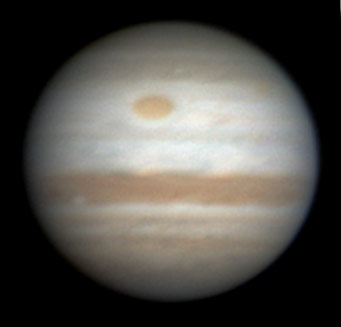
Jupiter's dark North Equatorial Belt is currently wide and massive, in contrast to the almost nonexistent South Equatorial Belt — whose absence leaves the Great Red Spot floating free in whiteness. Note too "Red Spot Junior" (Oval BA) adding a trace of color near the upper right limb. South is up.
Christopher Go in the Philippines took this image on May 6th at 20:42 UT, when the central-meridian longitude was 156° (System II). The Great Red Spot is near System II longitude 150°. Assuming it stays there, here's a list to print out of all the Great Red Spot's predicted transit times for the rest of 2010.
Mercury is having a poor apparition low in the dawn.
Venus (magnitude –3.9, moving from Taurus to Gemini) is the bright Evening Star shining in the west-northwest during and after twilight. Capella is the bright star far to its upper right. On Friday the 14th Venus poses midway between Taurus's horn-tips, Beta and Zeta Tauri. After that, these two stars slide away to Venus's lower right.
Mars (magnitude +0.9, in Cancer) is high in the west during evening, very far upper left of Venus along the ecliptic. Mars is moving eastward against the stars; week by week it's closing in on Regulus to its upper left. They'll pass each other on June 6th, 0.8° apart.
In a telescope Mars is just a tiny blob, 6.6 arcseconds in diameter. Can you still make out its gibbous shape? Mars is as gibbous as it will appear all year, with only 90% of its diameter sunlit.
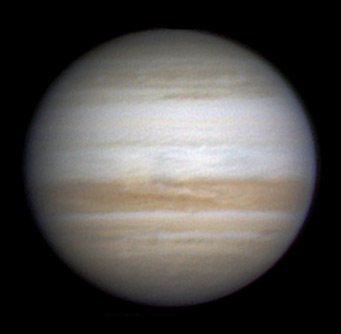
The other side of Jupiter (CM II longitude 4°), imaged by Go on May 17th. South is up. He writes: "There is a huge rift in the North Equatorial Belt (NEB). Something seems to be stirring up this region." Also, "The SEB is very pale. Note that the mid-SEB is a bit bluish. Note the white ovals on the SSTB. There are two white ovals on top of each other."
Jupiter (magnitude –2.2, below the Circlet of Pisces) shines in the east-southeast at the first light of dawn. Nothing else there is nearly so bright.
Saturn (magnitude +0.9, in the head of Virgo) is high in the southwest during evening. In a telescope Saturn's rings are tilted a mere 1.7° from edge-on, their minimum tilt for the next 15 years. They'll stay this narrow for the next month. Note the thin black shadow-line that they cast on Saturn's globe. The line is thicker and more prominent now than it was a few weeks ago.
Uranus (magnitude 5.9, in Pisces) is in the background of Jupiter at the crack of dawn.
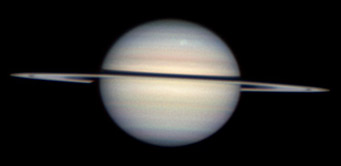
As of May 10th the Saturn Electrostatic Disturbance (SED) white spot was back yet again. This ammonia-blizzard thunderstorm is a very difficult eyeball sighting even in a large amateur telescope, but amateur stacked-video imagery like this is showing it again plainly. Amateurs have been creating a good record of the SED's brightenings and dispersals in the last few months.
South is up in this image taken May 10, 2010, at 11:21 UT, by Anthony Wesley in Australia. Click for his full-size images. The System III central-meridian longitude was 51°. The spot has been moving nearly 1° per day toward increasing System III longitudes since amateurs began imaging it two months ago.
Neptune (magnitude 7.9, at the Aquarius-Capricornus border) is in view just before dawn well to Jupiter's west (upper right). See our finder charts for Uranus and Neptune in 2010.
Pluto (magnitude 14, in northwestern Sagittarius) is highest in the south before dawn. See our Pluto finder charts for 2010.
All descriptions that relate to your horizon or zenith — including the words up, down, right, and left — are written for the world's mid-northern latitudes. Descriptions that also depend on longitude (mainly Moon positions) are for North America. Eastern Daylight Time (EDT) equals Universal Time (also known as UT, UTC, or GMT) minus 4 hours.
To be sure to get the current Sky at a Glance, bookmark this URL:
http://SkyandTelescope.com/observing/ataglance?1=1
If pictures fail to load, refresh the page. If they still fail to load, change the 1 at the end of the URL to any other character and try again.
 0
0
Comments
You must be logged in to post a comment.